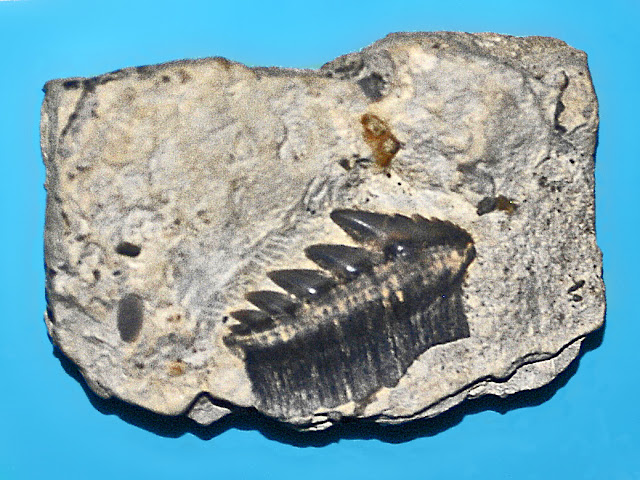The Devonian Era saw sharks developing and diversifying under the "rule" of larger armored fish like Dunkleosteus. Sharks diverged from their cousins, the Chimaeriformes, somewhere around the time of yesterday's animal, Cladoselache; this branching is not completely understood, even leading to some discussion, but nothing definitive, about placing Cladoselache in the Chimaeriformes group. As the Devonian Era came to a close (also the start of the Carboniferous Era, approximately 359 million years ago) approximately three quarters of all species on the planet became extinct, including many of the larger fish. This left an apex predator role open and sharks and chimaera expertly filled that role, continuing to diversify and increase their overall size. Many of the best known of the Carboniferous sharks are actually members of the Chimaera branch of the family tree. These include the anvil finned Stethacanthus and the wheel-mouthed Helicoprion. Despite being outshined by their Chimaera cousins during the Carboniferous, the sharks began to develop the characteristic jaws full of teeth that we now associate with sharks. The end Permian extinction (252 million years ago), which caused the extinction of approximately 96% of all marine, was significant for the shark species that survived. With their mouths full of teeth and few rivals (including their Chimaera cousins), sharks truly became masters of the ocean for some time; as marine reptiles evolved the balance of power would shift again. During the Jurassic Period (195 million years ago) the first modern sharks began to appear. These include the genus Hexanchus, which includes one of the oldest surviving lineages of shark: Hexanchus griseus, commonly called the Bluntnose sixgill shark.
Bluntnose sharks would fall into the common misnomer of "living fossil" as evidence of their existence is extensive in the form of fossilized teeth from the Mesozoic Era. The fact that more of its relatives are extinct than living and that this shark has a primitive body plan with a single dorsal fin, broad rounded pectoral fins, and a number of gills (six) that is between the more primitive sharks (possessing seven) and the more derived sharks (possessing five). The Bluntnose sixgill shark, one may complain, is not a fossil animal and therefore has "no place" on a fossil animal discussion platform. However, as a shark with more extinct relatives than living relatives, the living Bluntnose sixgill sharks is a living breathing representation of Hexanchus sharks that came before it. Not much has changed in this genus either; hence the "living fossil" misnomer. Hexanchus sharks (collectively known as "Cow Sharks" within the family Hexanchidae) belong to the order Hexanchiformes and are described as the most primitive group of sharks. To compare the living and the fossil is not always easy with these sharks, as many of the fossils are teeth and very little else (skin impressions do exist but are a bit more rare than teeth).



No comments:
Post a Comment